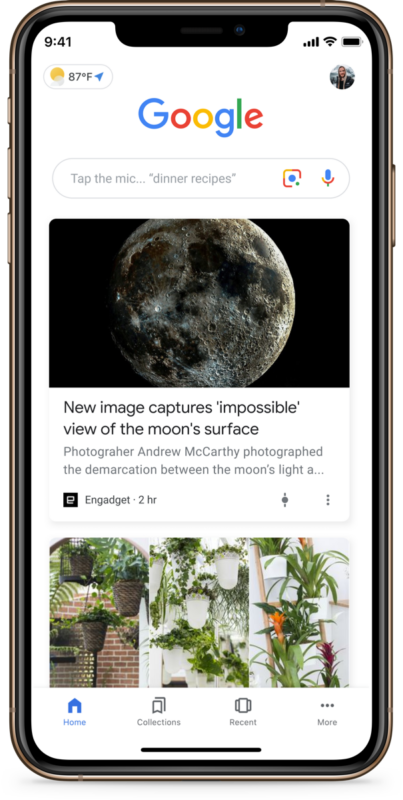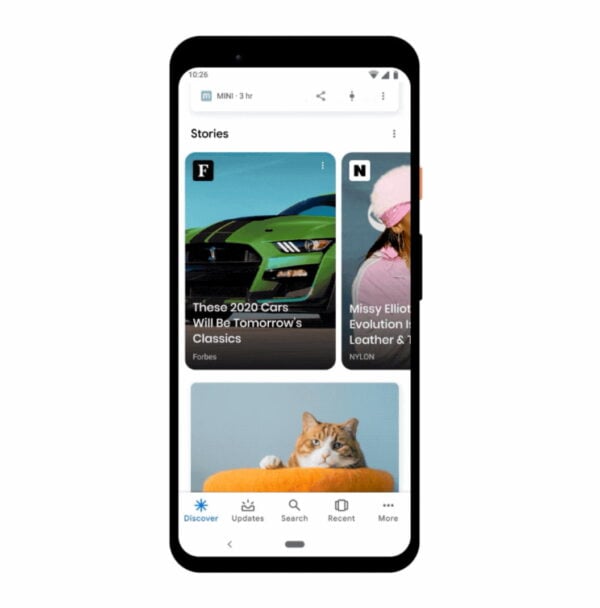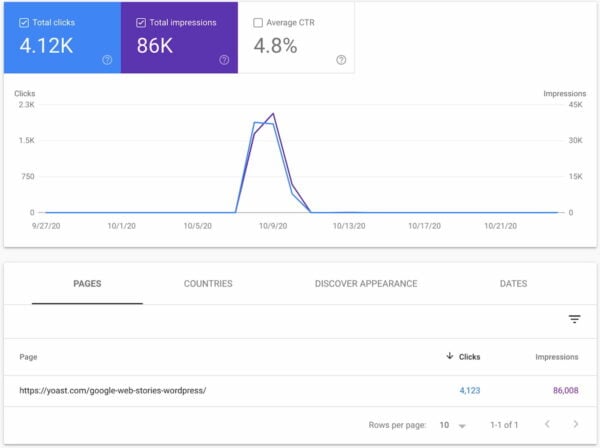Google Discover: What it is and how to get your content in

Google Discover offers users a different way to search. Actually, it’s not really a search in a traditional sense — it’s a queryless discovery of content that fits your preferences and interests. It suggests new content based on your search activity and interaction with the Discover app. And it learns what you like, so it can provide even better content the next time you use it. But how can you get your content in Discover?
What is Google Discover?
Google Discover is a mobile experience that lets you discover content you didn’t even know you needed. It is a different search experience, meaning the active searching part is mostly gone. If the system learns enough about you, you can keep swiping to keep the fresh content flowing.
Google suggests content for a user based on your search activity and activity found on your device. It looks at web searches, application activity, location history, and location settings. You can follow specific topics or entities to build your profile and set limits on what Discover should uncover for you.
Discover is an intelligent tool that learns how you search and what you like to provide you with the best or most timely content for your needs. Plus, it does that without you looking for it.
The Discover experience gets new stuff all the time. A while ago, Google added Web Stories to the feed. That’s useful because Web Stories are an excellent way to get eyeballs on specific types of content because of the mobile-oriented format. More on that later in this article. Google is also testing a Follow feature in its Chrome browser that lets users follow your site to see new content in their Discover feed. For this, Google uses your website’s RSS or Atom feed, so make sure to activate and link that properly.
Google moving from strings to things
These past couple of years, Google has been on a quest to move “from strings to things,” as they call it. For them, search is no longer about entering a query in a search bar resulting in a simple page with ten blue links. Today, searching takes the whole world into account and even makes that world an interface.
Google Discover takes the query part out of the equation and provides an intelligent system that suggests new content based on your activity and interests. It’s a different way of finding and experiencing content. It relies less on text and more on attractive visuals.
The goal of Discover is to make you come into contact with new but relevant things. Always there when you didn’t know you needed it. The system doesn’t take long to find out if you are on the lookout for something else — say, when you are planning your holiday. Your actions indicate changes, and new, timely, or evergreen content will pop up for your reading pleasure.

Google Discover is personal, so everyone will have their own experience with it. Discover will even take the knowledge you have with a topic into account. If you are beginning to explore a topic, you’ll get content for beginners. If you’re more advanced, you’ll get more advanced stuff. So there’s no way to get everyone to read the same article as not everyone is looking at it at the same time — or has an interest in it at the same time. But, once a reader has shown an interest in your brand or content by clicking an article, you’re on your way!
How to get your content in Google Discover
Getting your content in Discover isn’t that different from regular SEO, and there are no strict requirements. All the basic principles apply, so practice Holistic SEO whatever you do and adhere to Google’s guidelines and policies. You need to have outstanding content written for the right audience, plus you need to have a great website that offers a stellar user experience. Still, I’d like to highlight some things you need to remember.
Make great content
If you want to appear on Google Discover, content should be the focal point for everything you do. But not just any old content, no excellent, high-quality content that answers the questions your readers might have. At Yoast, we know the value of great content — it’s one of the reasons we’ve built tools such as the readability analyses.
Improve your content and write great headlines
The best way to get into Discover is to write better content than everyone else. Of course, if you have branded content, it might be easier to get in. But if your content is about general topics and you’re up against the competition, you must focus on quality. Research your audience, competitors, and industry and write the best possible piece on a relevant topic.
Make sure you know what kind of questions your readers are asking, and answer these in a way that is easy to understand and a pleasure to read. You could also try your hand at storytelling. Combining this with good visuals might make you stand out — not just on Discover but also on search.
As always, see what your competitors are doing. Is their content popping up in Discover? Try to find out how they did that. Did they do something special? Why do you think that that piece of content got in? Try to mimic their success — without copying, of course.
Take a look at your content. Does it have a powerful headline? Does it deliver on its promises? If you mention X in the title but never mention X in the article, it will not work. Be truthful, genuine, and authoritative. Write great titles and avoid clickbait stuff.
Write timely stuff
Discover can uncover content at a moment’s notice, which also goes for news-worthy content. Post your content on time, and it has a higher chance of doing well in Discover. Look at trending topics or popular subjects in your niche or industry and write about those.
But it’s not just new content that has a good chance of appearing in Discover. High-quality, evergreen content can do well. Since Discover learns what you do, changes in your habits trigger new types of content. So, if you are swiping your feed and see a news item about Croatia pop up, it might make you think about going there on holiday. If you follow up on that with a search about Croatia — or you follow the topic Croatia in Discover —you’ll get the latest on that topic and evergreen content. This is content that has proven its worth and keeps valuable at all times. Maybe something like the top 10 destinations in Croatia?
Improve expertise, authoritativeness, and trustworthiness
One of the most interesting lines in Google’s documentation on how to get your content into Discover is the passage on E-A-T:
Our automated systems surface content in Discover from sites that have many individual pages that demonstrate expertise, authoritativeness, and trustworthiness (E-A-T). Those looking to improve E-A-T can consider some of the same questions we encourage site owners to consider for Search. While Search and Discover are different, the overall principles for E-A-T as it applies to content within them are similar.
E-A-T stands for Expertise, Authoritativeness, and Trustworthiness — critical factors for determining how much you can “trust” a piece of content or its writers. In some industries, the author must have the skills and background to provide information that people can rely on.
One of those industries is the medical, financial, and many others. These sites are called Your Money or Your Life sites — YMYL for short. These sites offer advice that can directly impact people’s lives. For these, people need to know that you are who you say you are and have the required qualifications.
E-A-T is not just a factor for Discover; it’s increasingly helpful for Google to weed out misleading and, sometimes, plain dangerous content from the index. You need to prove that you know what you’re talking about for your content. Make sure that people understand why they should trust you. Let them know you are the authority on this subject!
Google collected some suggested reading on E-A-T, and we also have posts on Expertise, Authoritativeness, and Trustworthiness.
Support your entities with structured data
While you don’t need to apply special pieces of Schema structured data to get your content in Google Discover, it does make sense to make sure that your Schema implementation is top-notch. You must give as much information about your entities whenever you write about something.
Moreover, describing your content well also goes for what’s happening behind the scenes. If you support your entities with great structured data, search engines can use that data to get a firmer sense of what your content is about — and who wrote it. Yoast SEO has a flexible Schema implementation that helps you get the most out of it.
Make it visual
One of the most important parts of optimizing for Google Discover is the visual aspect. Discover is a visual medium. People scan a feed, swiping their way to content that looks and sounds appealing. One of the eye-catchers in Discover is the primary image of your content. This is one of the first things that your reader’s eye will focus on.
Make sure that your image stands out, but keep it relevant. Use compelling, high-quality images in your content. And make sure they are large enough to appear correctly in Discover. Your images must be at least 1200 px wide and enabled by the max-image-preview:large setting. Don’t worry; Yoast SEO adds this setting automatically for you.
Of course, this also goes for video. If you have a great video on a topic, add it to the content. As video is getting more critical by the day, having a way to make high-quality videos will pay dividends. Now, you don’t need a million-dollar set-up but make sure your video content looks professional. Make them engaging!
Improve your site
As always, there’s not one thing that gets your content listed in Discover quickly. Producing excellent content comes first, of course, but there are many other things to improve. If you’re aiming for Discover traffic, make sure that your site is perfectly usable on mobile. It has to offer an excellent user experience and load quickly — more on that in our Mobile SEO ultimate guide.
Try Google Web Stories
Discover is all about mobile. The ultimate stream of content helps you find whatever you weren’t thinking about at that moment. To reach these users, you have a new tool: Web Stories. A Web Story is mobile visual storytelling at its best. It’s Google’s take on the social media story format you all know from Facebook, Snapchat, and Instagram. But, this is open, findable in search — and Google Discover.
Web Stories are an excellent fit for Discover. The snackable, mobile-oriented stories are easy to discover and quick to swipe through. Building stories for your content might get you an easy way in the Discover feed. They are easy to build and quite fun too. Try it! Google is showing these stories under the Visual Stories banner on mobile.

Check your Discover performance in Google Search Console
Google Search Console helps you gain insights into your site’s performance in search and Discover. There’s a dedicated tab that enables you to analyze the performance of your content in Discover. Here, you can find your overall traffic over a more extended period. Also, you can dive into the traffic generated by specific posts.

Use these insights to learn about what your content does. Is it a straight line of continuous traffic, or is it spiking? Does it return? Why do you think a specific post got much traffic on a particular day? See if you can analyze these trends and make more informed decisions about your Discover content.
Test and improve
This article gives you a couple of insights into how Discover works and what you can do to get your content in. We hope these insights help you make the most of your work. While thinking of what Google Discover is, it would help if you remembered that Discover is a living, breathing thing built on what you feed it. What you see is different from what your friends see. That makes it difficult to predict success. Test, experiment, and fine-tune your way to success!


Can I use news schema for Google discover
Thank you for your comment! Yes, you can use news schema for your articles, but there is no guarantee that Google will use it for Discover. There is no specific schema type for Discover. Everything relevant you add to your page can make it easier for Google to understand the content and context, though. Just don’t try to turn an evergreen post into a news item :)
Hey, the blog is really nice and will help me a lot. It has all the effective points and the information is easy to understand .
thanks
Thank you for your comment! Glad we could help.
How to approve google news for job site which have many link in post.
please reply
Hi Raju! If you’re having a hard time getting your job site approved for Google News, it might be better to get your site ready for Google Jobs with JobPosting structured data. Good luck :)